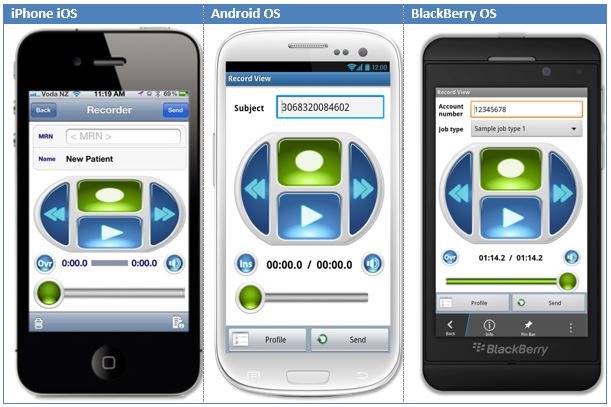Smartphones or dictation devices – decision-making approaches
Nowadays, the Smartphone is an indispensable part of daily healthcare practice for many doctors. Nevertheless there is a certain degree of unwillingness to introduce Smartphones as working equipment in hospitals. Reasons for this include issues concerning support and maintenance, data protection and the technical integration of equipment into a hospital’s IT infrastructure. These issues also apply to Bring Your Own Device (BYOD) concepts, although there are at least new approaches to establish Smartphones as working tools more simply and quickly and to increase their acceptance.
In recent years we have assisted various hospitals in introducing digital dictation using Smartphones, partly as an add-on and partly as a replacement to classic digital dictation equipment. The following criteria in particular have played a key role in deciding for or against the use of Smartphones:
Supply and functionality
The leading suppliers of dictation management solutions offer apps with similar capabilities for the four major operating systems (iOS, Android, Windows Phone 8 and BlackBerry 10). However, only a few providers enable connection from their Smartphone apps to Active Directory as well as the hospital information system (KIS). This is where we see the major advantages of dictating with Smartphones, as administrative patient information such as name, patient number and date of birth can be downloaded to a Smartphone and selected before dictation. This means there is a unique correlation between dictations and patients. In the case of some solutions, case or patient numbers can be scanned by barcode and additional information such as images or spatial data can be added. However, the most important requirement is still the aforementioned integration into the HIS so that dictations can be clearly allocated to cases and time-consuming searches can be avoided.

Challenges and limitations
Unlike a few years ago, there are now various installations in Swiss hospitals with integrated use of Smartphone apps for digital dictation. We have assisted our customers in implementing various different concepts: both as BYOD as well as introducing Smartphones provided by the hospital. Some customers have replaced their dictation equipment with Smartphones, however most of the time they are used as an add-on to digital dictation devices. It remains to be seen whether dictation apps for Smartphones will replace classic dictation devices in the medium to longer term. To make this possible, the following issues need to be clarified:
Data protection
There are still justified concerns regarding data protection when patient data is downloaded to mobile devices. One important aspect regarding access control is integration with Active Directory, with users not needing to use separate logins and passwords for the apps. In our experience, the major reason for stopping the introduction of Smartphones or tablets is security risks.
Infrastructure and costs
For security reasons, it is sometimes only possible to transfer dictations from an app to a server on the internal network, for which WLAN must be continuously available. However, this is not the case in a lot of hospitals, with the use of Smartphones as dictation devices for the most part dropping. If data can also be transferred from the mobile network and not just WLAN, it is important to clarify who will bear costs for data traffic besides clarifying the security criteria.
Data integration
One potentially great advantage of dictation using Smartphones is being able to exchange data bi-directionally with the HIS and assign dictations clearly to patients. At pre-defined intervals, patient data, for example, for each hospital or user, can be uploaded from the HIS to the app database and shown on Smartphones of authorised users. This sort of integration requires appropriate resources which need to be provided. On the other hand, the direct allocation of dictations to patient data means there are significant opportunities for process optimisation in Smartphone apps.
Finally, speech recognition also plays a key role in dictation via Smartphone or tablet. Speech recognition technologies are improving year on year, however the recording quality of a Smartphone cannot quite be compared to that of a microphone which has been optimised for speech recognition.
Conclusion
In short, the use of dictation apps has increased considerably in recent years despite the aforementioned reservations. In favour, we have opportunities for optimising the dictation process by integrating dictation and patient data, ease of use, as well as the “all-in-one” concepts of the Smartphone. However, challenges still persist concerning data protection and infrastructure which need to be addressed by both dictation management providers and hospitals. The next few years will determine whether apps can fully establish themselves as alternatives to classic digital dictation equipment.